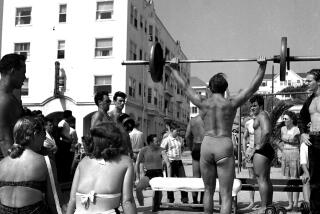The Power of Cool--and of Not Knowing What Cool Is
- Share via
Have you ever wondered just what it is that compels otherwise perfectly sane young men and women to go out and have their tongues pierced, or their eyebrows, or navels, or certain other body parts better left unspecified in a family newspaper?
Or do you wonder why your kids insist on wearing baggy gangster-style clothing despite the fact that they don’t belong to a gang and the clothes can get them into trouble?
Or why teenagers continue to get addicted to smoking when it has been clear for more than a quarter of a century that cigarettes are killers? Sociologists or psychoanalysts might give you any number of answers to such questions, but if you ask the kids themselves you’re likely to get a single straightforward answer. You know what it is: “Because it’s cool.”
But just try to get someone to define what “cool” is.
As a professor of popular cultural studies at Cal State Northridge, I’ve been spending a lot of time lately trying to figure out the essence of “cool” because I believe it to be one of the most potent cultural forces on the scene today. With millions of people, not all of them young, desperately seeking to be cool, or to acquire cool things, or to identify with cool people like movie and television stars, it seems that cultural analysts should at least be able to say what coolness is. For if we could define cool, we could go a long way toward understanding what kind of society we live in and what motivates us to do what we do.
Of course, I’m not the only one thinking about the problem. Everyone from ad agency executives to studio heads to television producers are all thinking about coolness these days, because nothing is so certain to turn a product, a movie, or TV series into pure gold as the popular declaration that “it’s cool.”
When I ask my students about the matter, I find that they know what is cool but not what cool is. They agree that what’s cool is constantly changing, but beyond that it seems impossible to come up with a general definition.
A dictionary will tell you that “cool” is slang for “pleasing” or “excellent,” but that doesn’t tell us what it is that makes cool things pleasing. The fact that one of its traditional non-slang meanings links coolness with audacity or impudence is more helpful, especially when viewed in the light of the modern history of cool. For cool first came in with the countercultural Beat movement of the 1950s, which could be both impudent and audacious indeed in its flouting of bourgeois conventions. Back then, jazz was cool, and so was the rejection of American materialism, conformism and consumerism. To be cool was to reject the mainstream and embrace the margin with a certain hip defiance.
Something of the Beat legacy lingers on today in the connotations of cool, especially when they include that popular pose known as “attitude,” but there are some significant differences. For one thing, coolness is no longer part of a subculture. It is a fully commodified component of mass culture. And for another, the quest for cool is often highly conformist as everyone tries to live up to the same cool standard. Indeed, coolness today often really isn’t rebellion at all; it’s a mass desire to emerge from the anonymity of the crowd by impressing others.
As I ponder the mystery of contemporary cool, I accordingly find the following formula emerging. The culture of cool is in essence founded upon a hunger for identity in a mass consumer society, a hunger that is satisfied through rituals of self-display. Another way of putting this is that coolness is closely related to a social phenomenon that sociologists call “other-directedness.” An other-directed person is someone who allows his or her actions to be determined by someone else. In the context of cool, other-directed people live their lives according to what they think others may think of them.
Adolescents, with their lacerating self-consciousness, are notoriously other-directed in this sense. It’s just something the young are expected to go through and then grow out of. But that doesn’t mean that we should encourage other-directedness through an endless bombardment of commercial images, products and entertainments that are precisely aimed at immature anxieties about being admired, about being cool. Yet that is exactly what is happening when practically everything in our consumer and popular culture reinforces the immature need to dance to the tune of how others see us.
What worries me about all this is that a culture of cool is in danger of losing its ethical anchoring. For when our behavior is dictated by a superficial concern over how we look to others rather than by the internal codes of conscience and self-reliance, all that is left is a slippery, amoral fetishization of what other people think. And as uncool as it may be to say so, this is not a sound foundation on which to build a healthy society.


